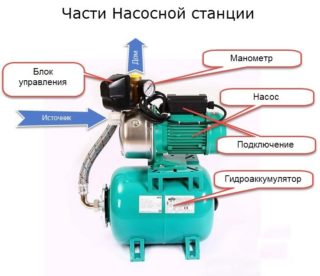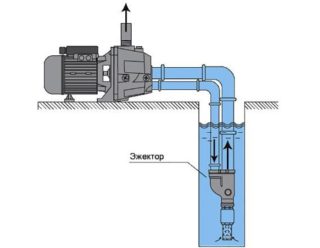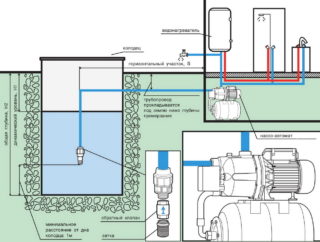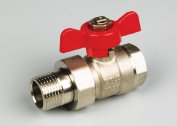The construction of an autonomous water supply system in a summer cottage will allow you to grow a rich harvest and spend time outdoors in comfort. To implement the idea, you need a budget and at the same time a productive pumping station, the power of which will fulfill the whole range of tasks assigned to it.
Types, device and principle of operation of pumping stations
 Before purchasing pumping equipment, you need to familiarize yourself with the principles of operation of each working unit. In the future, this will allow servicing and self-repairing the station. Important elements of pumping equipment are:
Before purchasing pumping equipment, you need to familiarize yourself with the principles of operation of each working unit. In the future, this will allow servicing and self-repairing the station. Important elements of pumping equipment are:
- a working unit with a filter designed for water intake;
- accumulator - drive;
- check valve, which prevents the movement of water in the opposite direction;
- electric motor;
- pressure switch, which allows you to adjust the pressure of the water supply;
- suction line - a pipe connected to a pump in a well shaft;
- pressure gauge that displays the exact pressure parameters on the panel.
The principle of operation of pumping equipment is cyclical. As soon as the liquid reserves in the system run out, the device turns on and starts pumping water, filling the water supply system. As soon as the optimum pressure is reached, the relay switches off the pump. It is necessary to regulate the operation of the relay before installing the equipment, the set parameters will depend on the technical characteristics of the model and the tank volume.
There are several types of water supply stations for giving out of the well. It is better to give preference to units with a centrifugal and self-priming equipment, additionally equipped with an ejector. Pumps with an external ejector are more suitable for deep wells.
How to choose a pumping station in the country
When buying a pumping station, you need to pay attention to the technical characteristics of the selected model and the parameters of the source from which it will pump water. Selection criteria that are recommended to rely on when purchasing:
- Permissible depth of fluid intake. It is worth analyzing not the static, but the dynamic level in the well.
- The capacity of the accumulator. For a family of two people, the optimal volume is 24 liters, out of 6 or more people you will need a capacity of at least 100 liters.
- The nominal head is the relative height of the water column that the pump can provide.
- Power consumption. Consumption indicators fluctuate between 500 - 2,000 watts.
- Performance pumping station.
- Working voltage.
It is recommended to go to the store for shopping already with knowledge of all the necessary parameters, since the purchase of equipment that is too powerful or too weak threatens to wear out the parts quickly and break them down.
Installation and Connection
In the warm season, you can install pumping equipment anywhere, the main thing is that there is a hydraulic source nearby. When it comes to winter, the station needs to be installed in a heated room.
Installation and connection rules:
- First, they begin to install a pipe supplying water to the pump, as well as a pipe supplying water to the places of water intake. The pipeline is laid in trenches below the depth of freezing of the soil, the well needs thermal insulation.
- The end of the pipeline is equipped with a check valve, which prevents the movement of water in the opposite direction.
- If the water source is a natural body of water, it is better to equip the system with a grill, which will protect the pumping equipment from foreign objects.
If, when you turn on the pumping station, water from the tap flows with impurities of silt and sand, do not sound the alarm. Perhaps the well’s resources have been used up, you need to wait until the water level in the well rises.
Advantages and disadvantages
Each pumping station has its advantages and disadvantages. The biggest advantage is that all important work units are already interconnected, therefore, do not need additional adjustment, installation and maintenance.
During operation, the station requires minimal financial costs. This is due to design features. It is protected from water hammer, pressure surges.
Among the shortcomings are noisy work and the inability to install equipment without additional mechanisms at a depth of more than 8-10 meters.
Installing a pumping station in a cottage to supply water from a well will solve a large number of problems, the main of which is the regularity of irrigation, which ensures a rich harvest. If there are difficulties in choosing, it is better to consult a professional.




